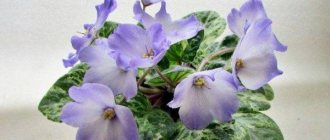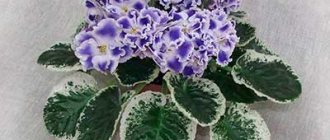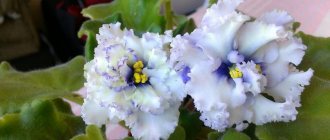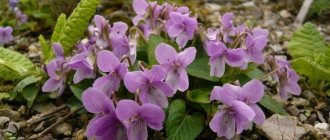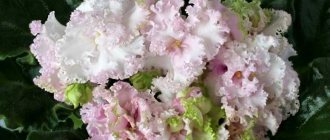Violet Winter Smiles, B. Makuni
The flowers are semi-double-double, light pink with wine-red strokes on the edges of the petals, behind which there is an elegant soft light green fringe, reminiscent of winter frost. The leaves are green with an olive tint, rounded, slightly elongated. Neat compact socket.
Properties
Name
- Original: Winter Smiles
- Transcription:
- Translation:
Registration
- Selection: B.Makuni
- Year:
Socket
- Socket type: standard
Flower
- Flower size, up to: 5.5 cm
- Flower shape: star
- Terry size: semi-double, terry
- Main color: pink
- Color type: plain
- Border: plain fringe
- Other features: brush strokes along the edges of the petals
Foliage
- foliage color: medium green
- foliage type: simple
- foliage shape: heart-shaped; quilted
- reverse side of sheet: pink
- leaf edge: jagged edge
- variegation: no
Description of the Grinya violet variety and photographs
Grinya violet was bred by breeder T. Dadoyan. The plant makes you wonder at the diversity of the world of violets. The variety produces completely green buds, which, as they open, turn into double flowers with white petals. The edge of the petals is decorated with a wide, densely corrugated green ruffle. When fully dissolved, the border becomes narrower, and by the end of flowering it disappears.
The leaves of Grinya violet are strongly wavy, large, and bright green in color. The violet rosette is neat, correctly formed, with leaves neatly arranged in a circle. Descending from the center of the rosette, they beautifully hug the pot. The socket size is standard.
Story
The author of this variety is Boris Mikhailovich Makuni, an outstanding domestic breeder. He was born on September 29, 1930. In memory of him, September 29 is celebrated as Violet Day. He and his wife Tatyana Nikolaevna, an active assistant in his work, began breeding violets in 1962. Until the mid-90s, the Makuni family bred about 300 varieties of violets. Its varieties have become popular in our country, America, Europe, Japan and still live in collections and delight us with their uniqueness, beauty, ease of care and propagation. On June 4, 2002, Boris Mikhailovich died. The variety Winter Smiles is the calling card of violets of his selection. Collectors have been trying to preserve this variety unchanged for many years.
Rules for caring for violets Winter smiles
Violet care activities consist of watering, fertilizing and timely replanting.
Watering rules
For proper development of the rosette and abundant flowering, the soil in the violet pot must be moderately moistened. For irrigation, use clean water at room temperature that has been standing for at least a day.
Water the violet at the root using a watering can with a long spout or a syringe bulb. Water should not get on the leaves or in the center of the rosette. If this happens, the leaves should be dried immediately with a napkin.
[adsp-pro-5]
You can avoid waterlogging of the soil by organizing wick irrigation. Experienced flower growers advise using this method for violets over the age of 2 years . To organize wick watering, a synthetic cord with a diameter of 0.3-0.5 centimeters is placed in the pot (depending on the age of the plant and the diameter of the pot).
The end of the cord is released from the drainage hole and placed in a vessel with water. The plant independently regulates the level of moisture in the soil, drawing water from the vessel as needed.
The Winter Smiles violet is watered strictly at the root.
Feeding schedule and features
The nutrients added to the soil during transplantation are enough for violets only for two months. Then the plant needs regular foliar feeding with organic and mineral fertilizers.
Maintaining a balance of nutrients is an important condition for the correct formation of a rosette and flowering appropriate to the variety.
An overdose is immediately reflected in the appearance of the violet:
- Excess nitrogen causes sudden and excessive development of leaf tissue to the detriment of linear growth. The leaves become fleshy, clumsy, and tangled in each other.
- Lack of nitrogen causes chlorosis and is manifested by yellowing of the leaves.
- Excess phosphorus causes yellow leaves and a small number of buds.
- Potassium deficiency affects flowering. The flowers develop very small.
Starting in April, violets are fed once every 2 weeks. It is advisable to use special fertilizers for violets in liquid form. The last fertilizing is applied to the soil in mid-September. Fertilizers are applied only to moist soil. Otherwise, the minerals will burn the plant roots and they will begin to rot.
The variety Winter Smiles is fed every couple of weeks.
Fertilizers should not be applied if the plant is weakened by disease or damaged by insects. In this case, the violet is first treated, and the first feeding is carried out 30 days after recovery. Fertilizers are also not applied if the room temperature is higher or lower than recommended for keeping violets. Heat and cold are stressful for the plant, and feeding at this time will only cause harm.
Rules for planting and transplanting
The correct selection of soil and container for growing violets is half the success of growing it. The plant requires the most loose, light and at the same time nutritious soil.
[adsp-pro-6]
Experienced flower growers advise making mixtures for planting and replanting violets yourself. To prepare the substrate, take leaf and turf soil (5 volumes) and humus (1 volume).
This mixture must be placed in a plastic bag and heated in the microwave for 3 minutes on one side and 3 minutes on the other. Then peat (3 volumes) and sand (1 volume) are added to the mixture. After thorough mixing, vermiculite and sphagnum moss are added to the prepared substrate, approximately 10% of the total volume obtained.
To transplant violets, you can use ready-made soil, which is sold in flower shops.
This mixture should be prepared for violets annually and transplanted into it in early spring. Old soil is not removed from the roots of young violets (up to 3 years old) when replanting. The plants are removed from the old pot along with a lump of earth and transferred to a new pot. 1-2 centimeters larger in diameter. For young plants, pots measuring 5 to 7 centimeters in diameter are suitable.
When transplanting an adult violet, the root system is completely freed from the old soil. Violets are planted in pots from 7 to 13 centimeters in diameter. As soon as the roots of the Winter Smile violet grow to a pot with a diameter of 12-13 centimeters, stop increasing the planting capacity.
When transplanting, the violet rosette is freed from the stepchildren. Only one rosette should grow in a pot, only then will the violet bloom. If the daughter rosettes are left in the pot along with the mother rosette, flowering will stop. Violet will spend energy on raising children.
Read the full description of the Sea Wolf violet variety.
We offer you to read a review of the Vodyanaya violet variety with photographs.
Peculiarities
Delicate pink flowers, quite large up to 5.5 cm, with a light green fringe and variable wine-red strokes along the edges of the petals, are located on strong peduncles with 3-5 flowers on each. Flowering is long and frequent. In cool conditions, the green fringe is brighter; in hot conditions, it turns white.
Over the many years of existence of this variety, some changes have occurred with the flowers. From photographs posted on the Internet, one can see simple flowers, bright pink, not with strokes of wine red, but with a border of the same color, with a heavily ruffled green ruffle. Such deviations are sports that do not correspond to the variety created by the author.
The rosette is of medium size for standards 20-23 cm, depending on the conditions of detention it can be larger. The rosette is smooth and flat under all conditions. The leaves are heavily quilted with a serrated edge. The variety feels equally good both in daylight and on a shelf; both with top watering and wick watering.
Propagates well by cuttings, produces from 2 to 5 children. The first flowers can be seen 7-9 months after rooting the cuttings.
A wonderful, very beautiful variety with delicate flowers. There are no problems in growing it, it can be recommended to novice collectors.
When buying a cutting, you need to pay attention to how the mother rosette blooms.
Features of flowering, growth and reproduction
Most violets reproduce in four ways , each of which has its own nuances. Winter Smiles has no restrictions on the method of obtaining offspring:
- Leaf cuttings:
- For this method, healthy material is selected from rows 3-4;
- The leaves are cut and the cut areas are treated with crushed activated carbon;
- Rooting is carried out using a convenient method: in water, soil or moss;
- For the water method, after the roots appear, they are planted in the ground; in other options, they simply wait for the babies to appear;
- This variety usually produces 2-5 children, and after they grow up, they are separated from the cuttings and planted;
- Further care is the same as for adults.
- Cuttings from flower growers:
- Living flower stalks, on which at least one flower is still preserved;
- All flower stalks are trimmed, the length should be about a centimeter to the node and half a centimeter above it;
- The cuttings are planted in soil or moss and covered to create a greenhouse;
- After some time, babies appear (the survival rate of cuttings is very low);
- They are seated until they get stronger, or when they feel cramped.
- Stepchildren:
- Stepchildren are laid in the axils of the leaves and for propagation they are grown until 4 leaves appear;
- Rooting is carried out in two ways: on the mother plant - it is deepened until the stepson touches the ground, and then wait for the roots to appear; cutting - remove the stepson with a sharp object, and then root it like a leaf cutting;
- The rooted stepson is planted in a pot of the appropriate size and continues to be cared for as an adult.
Most often, violets are propagated by leaves. - Seeds:
- Seeds are sown in the ground and covered to form a greenhouse;
- After the emergence of seedlings, they are opened (several hours a day, increasing the duration of ventilation);
- Grown-up children are seated in separate flowerpots and cared for like other individuals.
This variety grows quite quickly , the individual reaches maturity by 10 months, and the first flowering can occur even earlier. For a good exhibition rosette, it is better to grow it under artificial lighting, but the flowering is brighter on the windowsill.
Violet Winter Smiles has an unusual color of flowers.
Flowering is abundant, flower stalks are powerful and there are many of them, often pampering owners with cap blooms . The buds bloom for a long time and open gradually. During its existence, many variations of sports varieties from Winter Smiles have appeared. Usually, instead of cherry strokes on the petals, sports have a border; their ruffle is usually much more corrugated than that of the classic version.
Important! In the heat of summer, the flowers may darken; this is a standard process for most violets, especially those that have white and pale pink areas. This is a consequence of brighter lighting, but this only occurs in natural conditions.
Photo
Violet Winter Smiles, B. Makuni, photo by T. Lysikova:
The flowers are just beginning to bloom:
First flowering:
